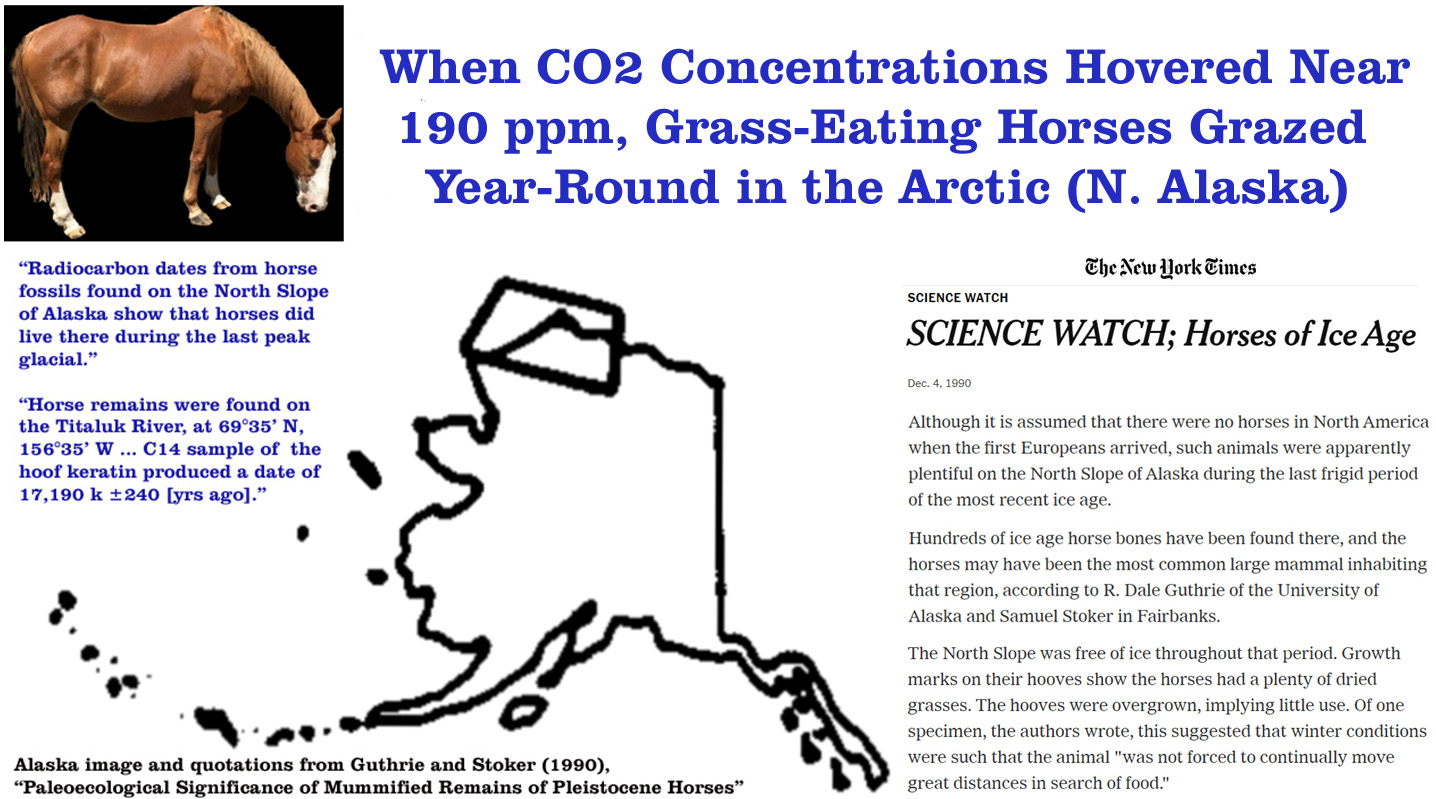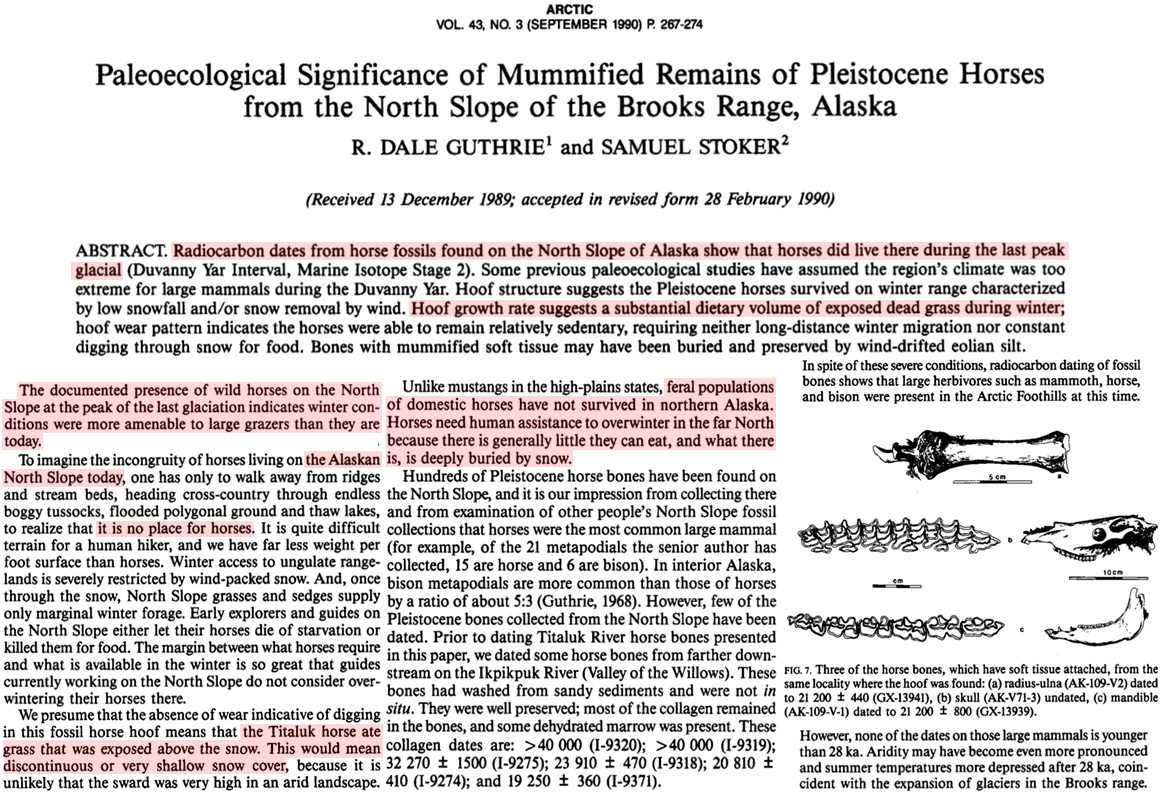In a new study, scientists report that about 17,000 to 20,000 years ago, when CO2 levels hovered near 190 ppm, “summer temperatures were higher here [North Slope, Alaska] than they are today” (Kuzmina et al., 2019).

Image Source: Guthrie and Stoker, 1990 and The New York Times
In the modern climate, North Slope, Alaska (north of the Arctic circle) has a mossy tundra terrain and an absence of trees.
About 8,000 to 9,000 years ago, with CO2 levels lingering around 260 ppm, this region was imbued with both trees and animal species that today live many 100s of km south (Kuzmina et al., 2019).
Even during the Last Glacial Maximum (LGM) 17,000 to 20,000 years ago, when CO2 levels hovered near 190 ppm, “summer temperatures were higher here than they are today” (Kuzmina et al., 2019).

Image Source: Kuzmina et al., 2019
During the LGM, horses were the most common large animal living in this region of the Arctic, followed by bison. Horses had a “substantial dietary volume” of dried grasses year-round, even in winter (Guthrie and Stoker, 1990).
Even though CO2 concentrations have reached 410 ppm today, 220 ppm higher than during the LGM, Northern Alaska is too snow-covered and frigid for horses to occupy this region now.
As Guthrie and Stoker, 1990 conclude, the Arctic is presently “no place for horses” because there is too little for them to eat, and the food there is to eat is “deeply buried by snow”.






Incredible that this appears now! Amazing!
First question, why then did the horses become extinct in the America’s until the Spanish brought them back?
But far more importantly, see Gangadhar Tilak’s Arctic Home in the Vedas, and The Orion. Tilak was Ghandhi’s mentor, spent years in jail, even efter presenting this thesis at a 1902 conference in Britain.
Tilak raised the apparent paradox of a relatively warm Arctic during glaciation (which is always on land) and establishes a link to both European and Hindi culture as Arctic peoples migrated south because of an ice deluge. Even better he can actually date this with constellations in todays rituals – they had to be further north than 60Deg. Indo-European takes on a whole different meaning and time scale,
possibly more than 28,000 years.
This did not sit well with the British Empire, first that a mere colonial could discover this, but a direct Indo-European relative!
So they push exclusively the west-east track to explain the language parity.
This will not sit well with Britain’s Extermination Rebellion either.
Dating is done with northern constellations and pole precession.
That the horses became extinct there likely means they were viewed as food, not coralled, although that is pure speculation. The astronomical knowledge of these people surpasses that of the green mob today.
The Arctic peoples did look to the stars, and we should too with Artemis.
Tilak showed todays Hindi calendar made sense only north of 60Deg.
With major glaciation, the arctic was a grassy plain, with much lower sea levels. That flooded or was deluged by ice causing a southern migration by boat, sea and river.
It seems odd that you quote a paper presented in 1902. That was a very bad period in prehistoric research it was when Kaiser Wilhelm ll was obsessed with proving the antiquity of the German people. with very bad results later in the century. There was no evidence of this in the arcaheological record but he was obsessed with Indo Europeans ,too. There was a lot of talk of ancient Indo European contacts with “Germania”. but that was in 1902.
Interesting material. Thanks.
The photo of the horse – maybe from the NYT or the original article ? – looks more like a USA western style Quarter Horse than a breed that could live on the North Slope.
American Quarter Horse
~ ~ ~ ~
Check the summer vs winter photos on the following:
https://en.wikipedia.org/wiki/Yakutian_horse
Yakutian horse is described as sturdy stature, thick mane and heavy hair coat.
Thanks, John. That makes a lot more sense.
This doesn’t make much sense for me, since I believe that during the last ice age there was a ice bridge between Russia and Alaska.
That doesn’t mean I believe CO2 is controlling the temperatures anyway.
That would be a land “bridge”, insofar as it was land, but not a bridge.
https://en.wikipedia.org/wiki/Beringia
Note the map, right side, is on a timer.
Watch the years tic by.
Beringia was about 3-4°C warmer than today earlier in the Holocene, when CO2 was in the 200s ppm. Sea levels were also meters higher than now back then (~6000 years ago), so it’s likely the chasm between the two countries was much wider than today.
The reason for the extinction of the horse and bison (and mammoth) species in the North Slope (AK) is tied to the flooding of the dispersion routes and lack of food due to some of the dozens of abrupt natural climate changes (degrees of warming within decades) during the last glacial (which occurred as CO2 remained steady and low at about 200 ppm).
D. Mann et al., 2015
https://www.ncbi.nlm.nih.gov/pmc/articles/PMC4655518/
“megafaunal species, like mammoth, horse, and bison, experienced boom and bust cycles during the ice age as they tracked rapid climate changes. For these species to persist, long-distance dispersal was necessary. Their extinction on the North Slope occurred as the ice age ended, because rising sea level severed dispersal routes and spreading peat simultaneously degraded range quality.”
With so much water trapped in the massive continental ice sheets, sea levels were 200m lower. That exposed a large plain, warmer and north of than the glacier regions, a paradox.
See Wrangel Island on that Beringia animation – some petroglyphs under the current sea level have been found, and possibly the last living mammoths survived there.
More about horses — begins with text about cave art.
Sci. American, 2015
To suggest that the horses had overgrown feet because they had plenty of food and did not move about is a furphy . Horses hearts pump blood to the feet and the frog
( which is similar to very hard rubber) on the underside of the hoof expands and contracts with movement , thus pumping the blood back up the leg. Without movement there is very poor circulation in the feet which can become life threatening. Horses have to move. I would rather suggest that their feet were not worn because they were moving in soft or boggy ground.
In other words, the Earth’s crust had shifted so that Siberia was at the north pole and Alaska was in the temperate zone. And then, there was another shift to the current rotational axis.
https://www.youtube.com/watch?v=EoqBp2nW5rg
[…] https://notrickszone.com/2019/10/10/during-the-last-ice-age-190-ppm-co2-horses-grazed-in-a-forested-… […]
[…] During The Last Ice Age (190 ppm CO2), Horses Grazed In A Forested, Warmer-Than-Today Arctic Alaska […]
[…] https://notrickszone.com/2019/10/10/during-the-last-ice-age-190-ppm-co2-horses-grazed-in-a-forested-… […]